OnePlus Open vs. Samsung Galaxy Z Fold 5: Which foldable phone wins?
We compare the cameras, displays, performance and more to find the best foldable phone
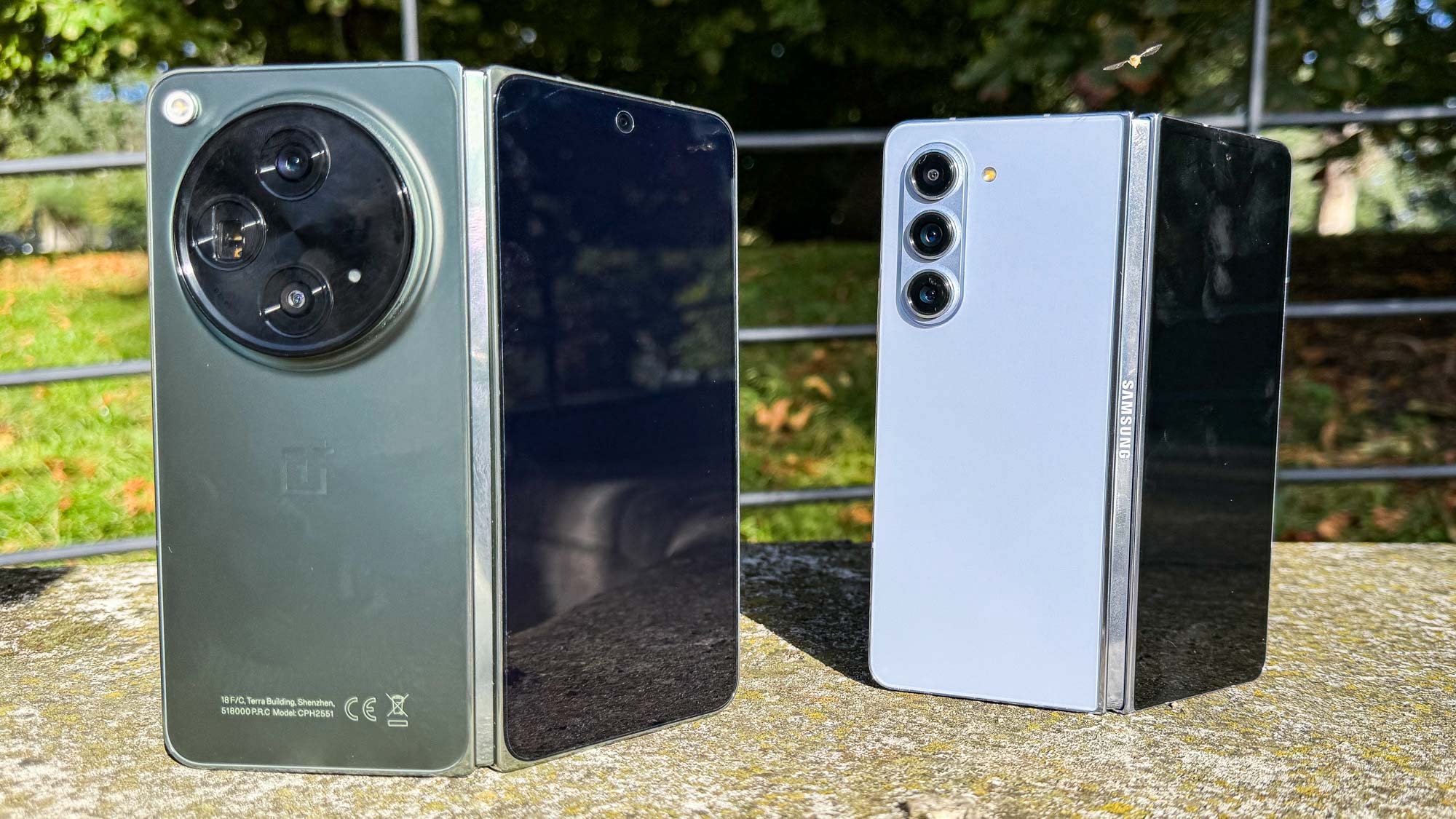
You can see the OnePlus Open vs. Samsung Galaxy Z Fold 5 match-up as one between a newcomer to foldables and a well-established veteran that’s earned a reputation as the best foldable phone overall. Or you could see the face-off as one where a maverick flexible phone attempts to unseat the somewhat stale current champ. Either way, the competition between these two foldable is close.
The OnePlus Open has an easy appeal because of its lower price, larger size, more comfortable shape, superior battery and charging and improved multi-tasking abilities. But the Samsung Galaxy Z Fold 5 remains a better device for photography and display quality, and it turns in stronger performance than its new rival. As a result, it's hard to pick a definitive winner.
If you're trying to figure out which device should be the one you buy — especially if you’re looking for your first foldable — read on to see exactly how the OnePlus Open and Galaxy Z Fold 5 compare, and what that could mean for your purchase.
OnePlus Open vs. Samsung Galaxy Z Fold 5: Specs
| Row 0 - Cell 0 | OnePlus Open | Samsung Galaxy Z Fold 5 |
| Starting price | $1,699/£1,599 | $1,799 / £1,749 |
| Inner display | 7.82-inch 2K (2440 x 2268) OLED | 7.6-inch QXGA+ (2176 x 1812) OLED |
| Outer display | 6.3-inch 2K (2484 x 1116) OLED | 6.2-inch HD+ (2316 x 904) OLED |
| Refresh rate | 120Hz | 120Hz |
| Chipset | Snapdragon 8 Gen 2 | Snapdragon 8 Gen 2 for Galaxy |
| RAM | 16GB | 12GB |
| Storage | 512GB | 256GB/512GB/1TB |
| Rear cameras | 48MP main (f/1.7), 48MP ultrawide (f/2.2), 64MP 3x telephoto (f/2.6) | 50MP main (f/1.8), 12MP ultrawide (f/2.2), 10MP 3x optical telephoto (f/2.4) |
| Front cameras | 32MP outer (f/2.4), 20MP inner (f/2.2), | 10MP outer (f/2.2), 4MP inner under-display (f/1.8) |
| Battery | 4,805 mAh | 4,400 mAh |
| Charging | 67W wired | 25W wired, 15W wireless |
| Size (folded) | 6.0 x 2.89 x 0.46/0.47 inches (153.4 x 73.3 x 11.7/11.9mm) | 6.1 x 2.64 x 0.53 inches / 67.1 x 154.9 x 13.4mm |
| Size (unfolded) | 6.0 x 5.63 x 0.23 inches (153.4 x 143.1 x 5.8/5.9mm) | 6.1 x 5.11 x 0.24 inches / 129.9 x 154.9 x 6.1mm |
| Weight | 8.43/8.64 ounces (239/245 grams) | 8.92oz (253 grams) |
OnePlus Open vs. Samsung Galaxy Z Fold 5: Price and availability
Originally released in July 2023, the Galaxy Z Fold 5 costs $1,799/£1,749. That’s unchanged from the last few Galaxy Z Fold models. The OnePlus Open launches October 26, and is priced at $1,699/£1,599, which is a touch cheaper. OnePlus’ phone also offers a higher base memory spec (16GB RAM/512GB) compared to the Galaxy Z Fold 5 (12GB/256GB).
You'll likely find Galaxy Z Fold 5 deals that lower the price, especially now that the phone’s been on sale for a few months. OnePlus' device is brand new, but during the pre-order window running through October 26, the phone maker will give you at least $200 off in return for any device, no matter the condition. That makes the Open an even better value purchase, at least if you're happy pre-ordering.
Winner: OnePlus Open
OnePlus Open vs. Samsung Galaxy Z Fold 5: Design
The Galaxy Z Fold 5 is the latest in a line of similar-looking Samsung foldables. Its narrow profile opens out in a square inner display, with a line of vertically-arranged cameras on the back.
The OnePlus Open looks more distinct, especially since it's the first foldable that OnePlus has ever produced. Its rounder, squatter body conceals a similarly square inner display, but the rear cameras are housed in a rather large circular camera block, bearing the logo of partnering camera company Hasselblad.
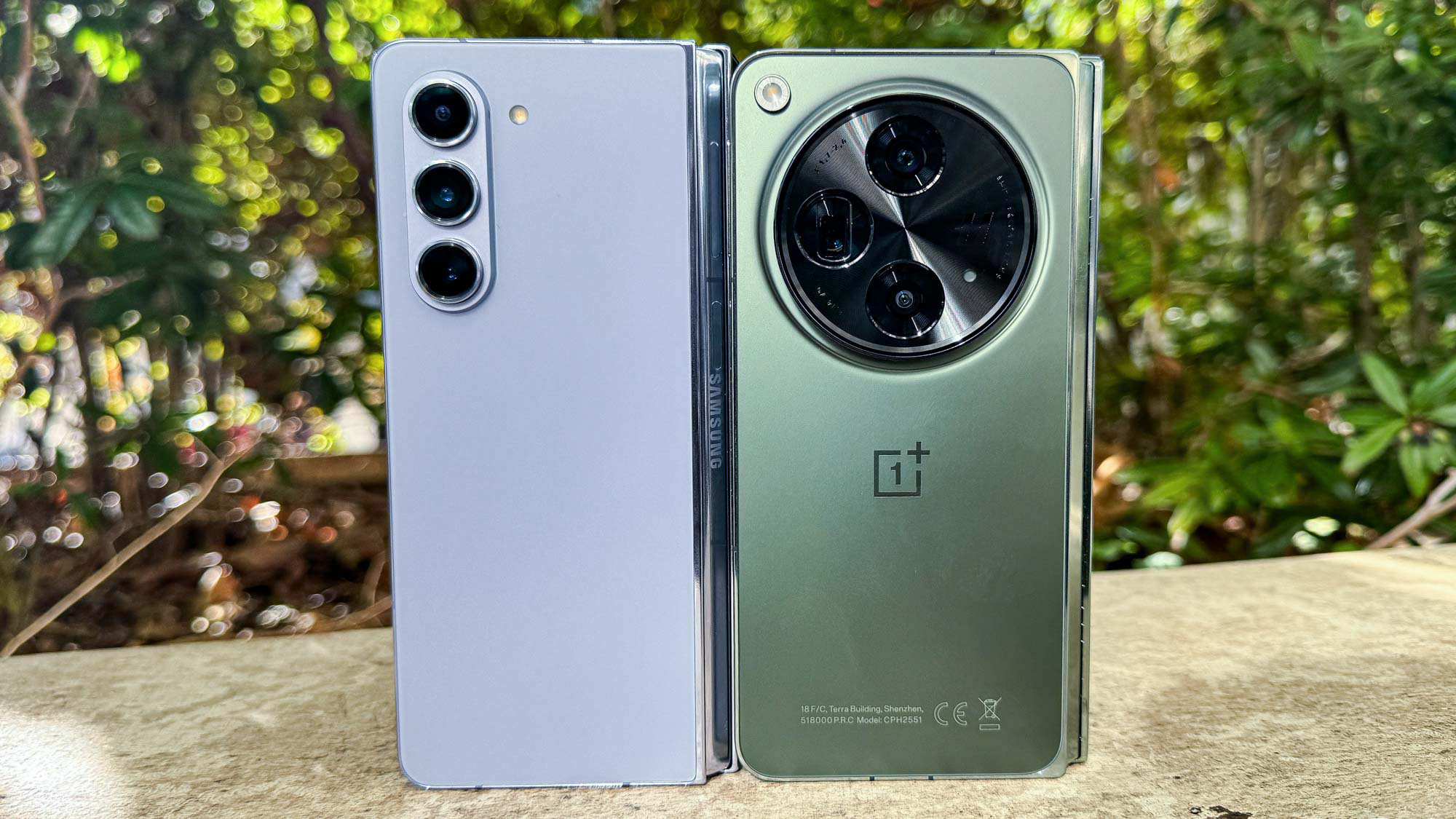
The OnePlus Open also features an alert slider to swap between ring, silent and vibrate sound profiles. This isn't unusual for a OnePlus flagship phone, but it is not something we've seen on a foldable before, including the Galaxy Z Fold 5.
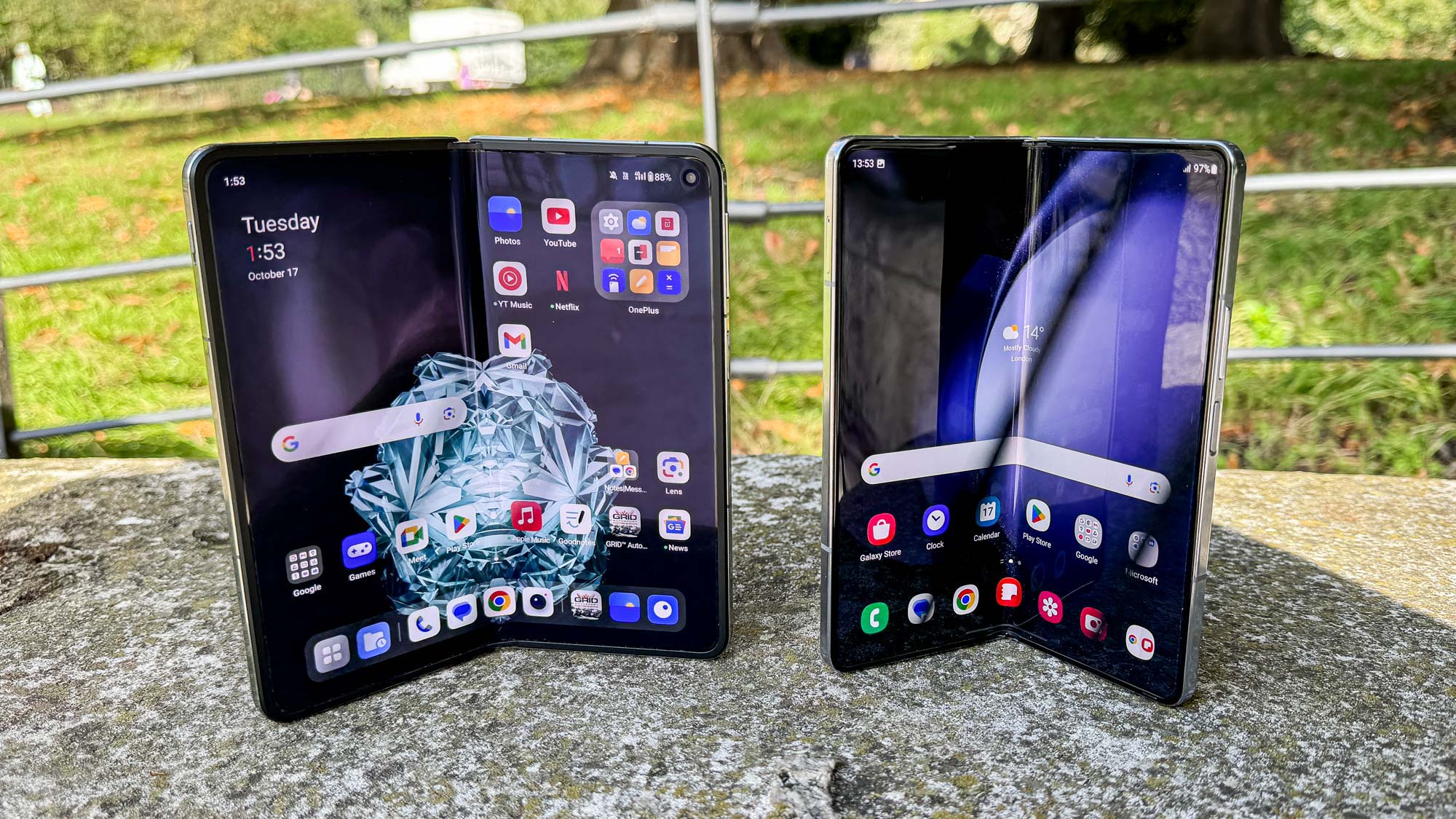
Both foldables come with an IP rating for protection against water (though sadly not against dust). The Galaxy Z Fold 5 has an IPX8 rating, which is in theory the same level of water protection you get from the best non-foldable phones. OnePlus has had the Open rated at IPX4, which signifies that the phone is at least splash-proof, but not able to withstand immersion like the Galaxy Z Fold 5's rating indicates.
Winner: OnePlus Open
OnePlus Open vs. Samsung Galaxy Z Fold 5: Displays
OnePlus has equipped the Open with a 6.3-inch outer display, which is a touch larger than the 6.2-inch display on the outside of the Galaxy Z Fold 5. More importantly, the two phones have very different aspect ratios — Samsung's being tall and thin, and the OnePlus having a more familiar wider and shorter profile. It means the Samsung is easier to use with one hand while closed, but the OnePlus behaves more like a regular phone when shut, which could prove advantageous for certain apps.
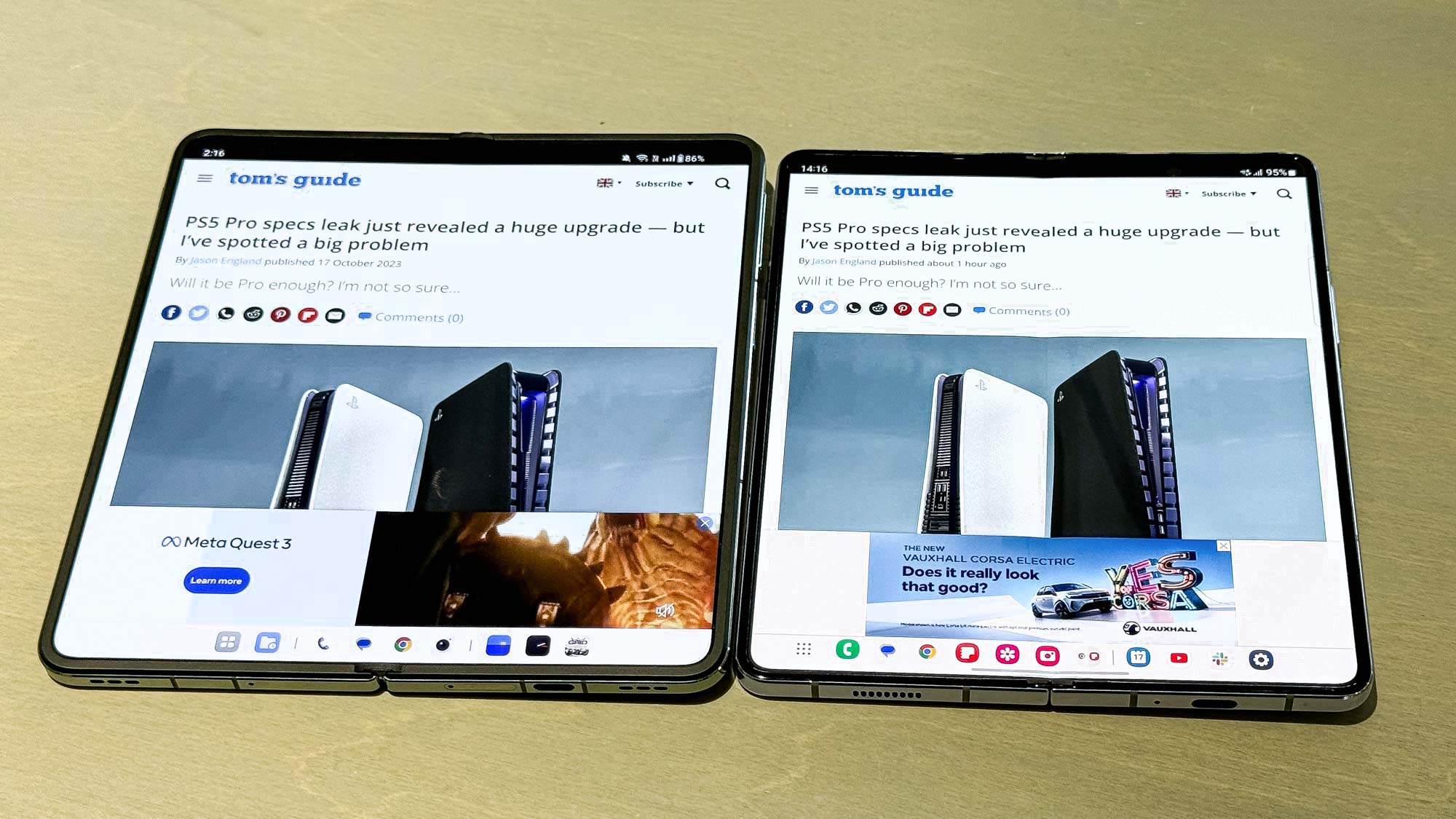
On the inside, the OnePlus Open again outsizes the Galaxy Z Fold 5 with a 7.8-inch display to a 7.6-inch one. The aspect ratio difference is minimal here, with both offering nearly square displays.
| Row 0 - Cell 0 | OnePlus Open | Samsung Galaxy Z Fold 5 |
| Main display peak brightness (nits) | 1,158 | 1,535 |
| Outer display peak brightness (nits) | 721 | 703 |
| Main display DCI-P3 color gamut coverage (%) | 79.2 | 140.6 |
| Outer display DCI-P3 color gamut coverage (%) | 80.6 | 128 |
| Main display Delta-E color accuracy rating (lower is better) | 0.14 | 0.11 |
| Outer display Delta-E color accuracy rating (lower is better) | 0.13 | 0.1 |
In our lab testing, we found that what the Samsung lacks in size, it more than makes up for in brightness and color. The figures above show this further, both when looking at outer and inner screen results.
Winner: Samsung Galaxy Z Fold 5
OnePlus Open vs. Samsung Galaxy Z Fold 5: Cameras
Both phones feature five cameras, serving the same functions but with different amounts of megapixels. The OnePlus Open uses a 48MP main camera, 48MP ultrawide shooter and 64MP telephoto lens with 3x optical zoom on the back; a 20MP punch-hole camera is on the inside of the phone while a 32MP punch hole camera sits on the outside with the cover display.
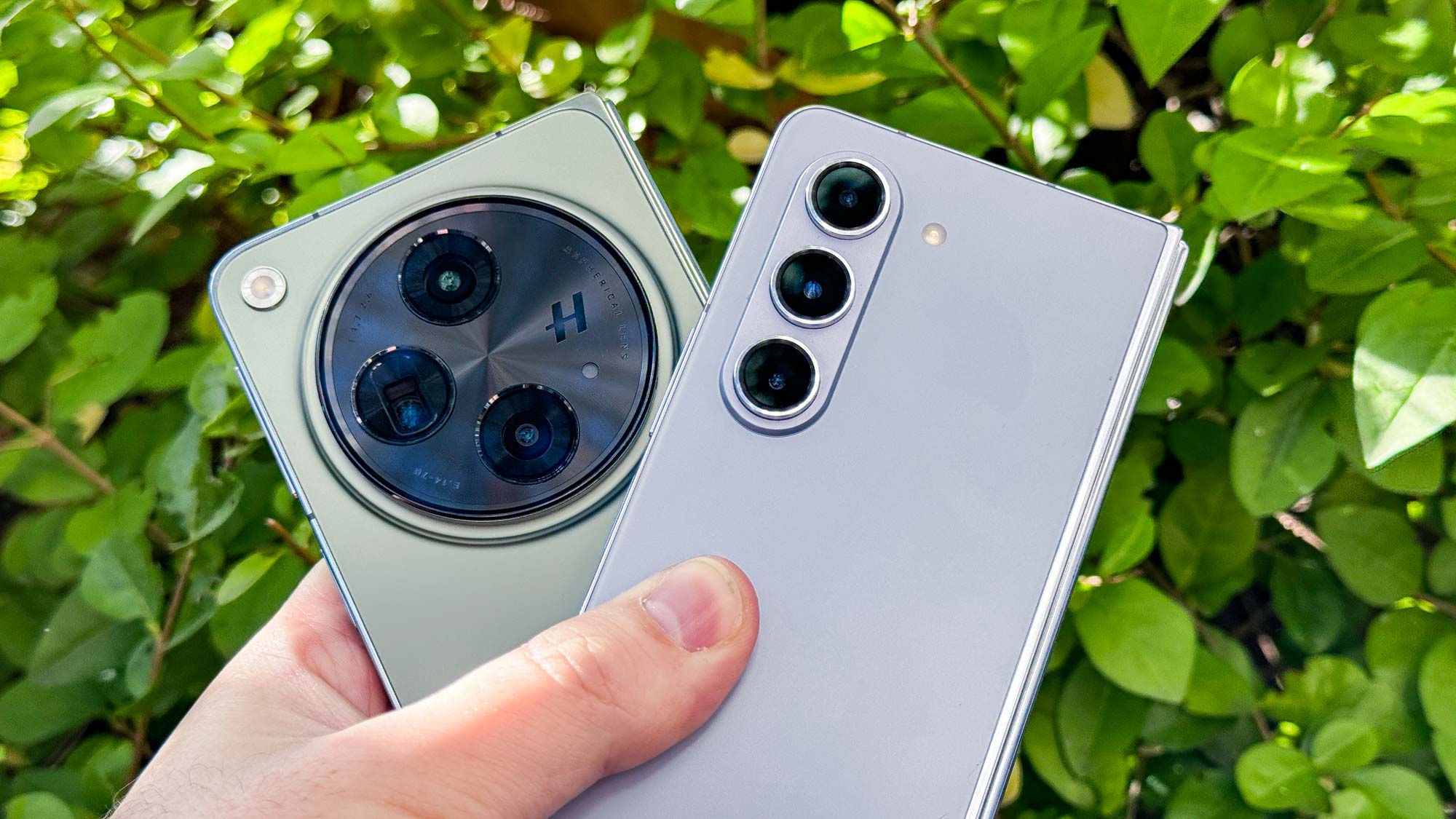
As for the Galaxy Z Fold 5, it has a 50MP main camera, a 12MP ultrawide camera and a 10MP telephoto lens with a 3x optical zoom on its back. You can take selfies either with a 4MP under-display selfie camera on the interior screen or a 10MP punch-hole selfie camera on the outer display.
The OnePlus definitely has an advantage when it comes to total megapixels, but Samsung's phones have historically had some of the best photo processing of any smartphone. And that's something you'll definitely notice in the camera samples below.
This main camera image of an urn in Hyde Park's Italian Gardens is warmer through the lens of the OnePlus Open, and has managed to capture greater range of the textures of the ram's face than the Z Fold 5 has. The Z Fold's shot is by no means a bad one though, and it offers the super-saturated color typical of Samsung phones.
I also tried a closeup of a leafy pot plant, and found the roles reverse. The Galaxy Z Fold 5 could get in much closer while keeping the frontmost leaves in focus, and has helped their "hair" appear sharper too. The muted colors of the OnePlus Open's photo don't look too good either in comparison to the more brilliant Samsung image.
In a night mode image of the Boston Arms, we see a very strong performance from the Galaxy Z Fold 5. Its image is much brighter, particularly in the darker areas of the scene, helping make the detail of the brick and stonework pop out. It's also much sharper than the noisy image of the Open.
We see a stark difference in brightness in this ultrawide shot, which offers a tricky mix of light and shade thanks to the arches of the Italian Gardens' pavilion. The Open's photo is the brighter of the two, but again loses to the Galaxy Z Fold 5 on color richness. Neither phone does well capturing the shadowiest parts of the scene though.
I pointed the two phones' telephoto cameras at this statue of two hugging bears, and managed to get some genuine bokeh from both, but especially from the OnePlus Open. Both phones also do well at capturing the texture of the metal sculpture, but the OnePlus is again champion when it comes to an accurate and natural depiction of the scene's colors.
Now we come to the first of two selfie shots, starting with a portrait image using the outer front-facing cameras. Samsung's foldable wins when it comes to the quality and neatness of the portrait effect, and offers a better overall coloration of me and the background. The OnePlus Open makes parts of the scene like my coat and my hair look too dark, which makes the details harder to appreciate.
Lastly, we test the interior cameras of our two foldables. Samsung's inner selfie snapper is an under-display camera, which means when viewing video or games or just your home screen, there's no camera hole to distract you from what you're looking at. The downside is that cameras taking images through a layer of display pixels makes the image a lot softer, which isn't always what you want.
In a brightly-lit photo like this selfie though, Samsung’s output still looks all right. As soon as you zoom in on it and the OnePlus Open version, though, you can see that the Open's image is far better, even if it still renders the darker parts of the scene tricky to see.
Winner: Samsung Galaxy Z Fold 5
OnePlus Open vs. Samsung Galaxy Z Fold 5: Performance
Pitting the performance of these two foldables together means testing out how the Snapdragon 8 Gen 2 inside the OnePlus Open does against the Snapdragon 8 Gen 2 for Galaxy, Samsung's exclusive higher-performance version of that same chipset. And the result isn't too much of a surprise.
The OnePlus phone still scores a win in the 3DMark GPU test, but it loses out on the Geekbench 6 CPU test, and in the Adobe Premiere Rush video transcoding test. This isn't a surprise considering the Samsung's custom chip and its higher clock speed.
| Row 0 - Cell 0 | OnePlus Open | Samsung Galaxy Z Fold 5 |
| Geekbench 6 (single-core score / multi-core score) | 1087/4203 | 1995/5342 |
| 3DMark Wild Life Unlimited (score / frames per second) | 14157 / 84.8 fps | 13,579 / 81.3 fps |
| Adobe Premiere Rush (time to encode, mins:secs) | 1:08 | 0:41 |
The OnePlus Open and the Galaxy Z Fold 5 trade blows when it comes to RAM and storage. There's a single 16GB RAM and 512GB storage spec for the OnePlus, which is more RAM than the Galaxy Z Fold 5 offers, and more storage capacity than the Samsung offers by default. But the Samsung foldable gives you a choice of storage options, starting at 256GB, and going up to 512GB and 1TB if you're prepared to pay a few hundred dollars extra.
Winner: Samsung Galaxy Z Fold 5
OnePlus Open vs. Samsung Galaxy Z Fold 5: Battery and charging
With a 4,805 mAh capacity and 80W charging (67W for U.K. buyers), OnePlus Open's battery is larger and faster to charge than the 4,400 mAh Galaxy Z Fold 5 and its 25W charging speed.
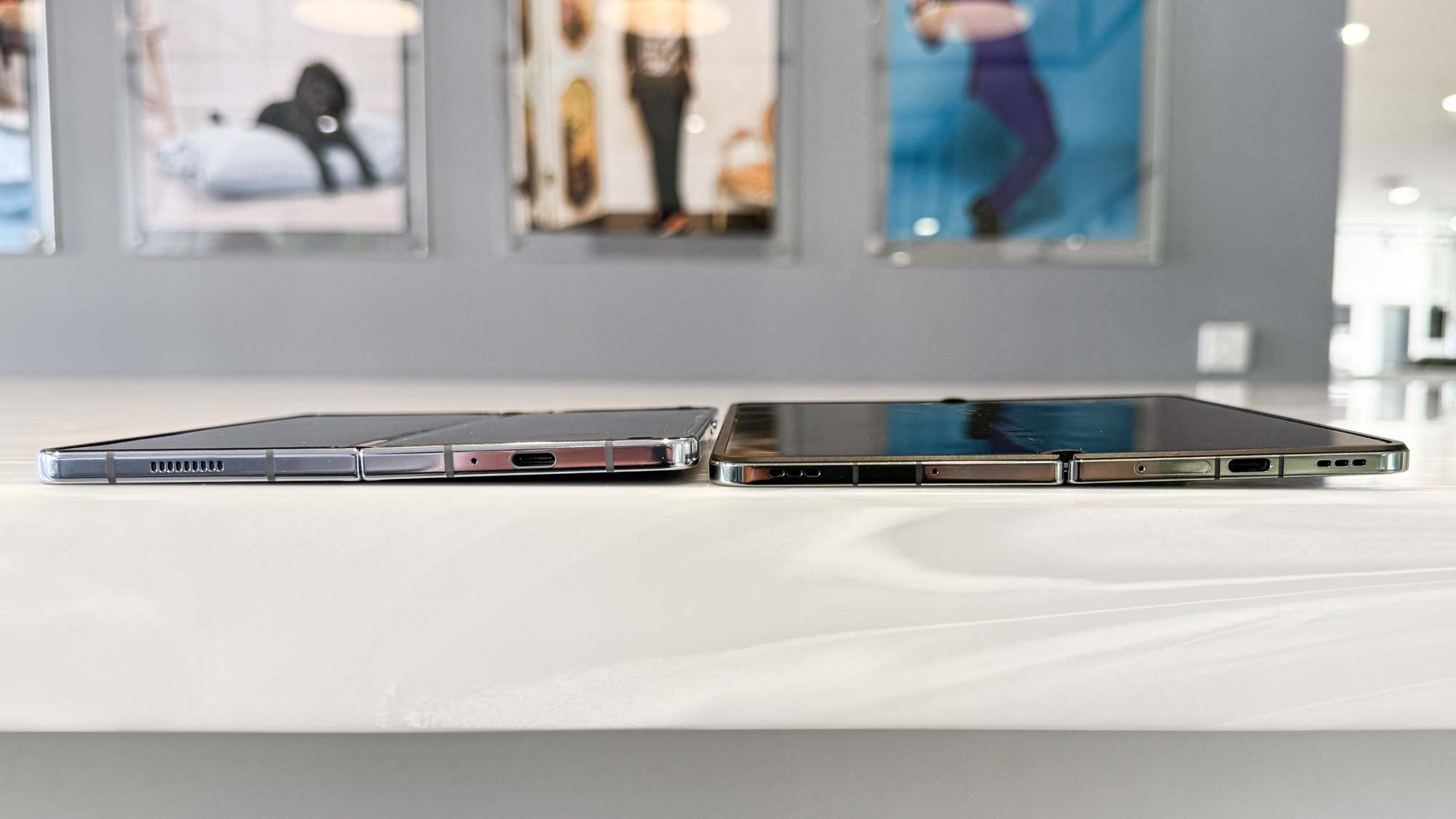
As you'd expect from its larger battery, the OnePlus Open lasts a little bit longer on our battery test than the Galaxy Z Fold 5. The Open managed to constantly browse web pages over cellular internet for 11 hours and 31 minutes, set at its default 120Hz with its main screen open. The Galaxy Z Fold 5 achieved 11 hours and 15 minutes on the same test.
You can power up the OnePlus Open to 85% full in the same 30 minutes it would take to charge the Galaxy Z Fold 5 to 55%. But the Samsung has one charging trick up its sleeve: it supports wireless charging while the OnePlus doesn't.This is an unfortunate feature to leave off of a phone of this price, but also fits in with OnePlus' irregular use of wireless charging on its other phones.
Winner: OnePlus Open
OnePlus Open vs. Samsung Galaxy Z Fold 5: Software and special features
Both the OnePlus Open and the Samsung Galaxy Z Fold 5 run on Android 13, but due to the unique designs of OxygenOS 13.2 and One UI 5, they look and feel quite different to use.
Foldables have a greater focus on productivity than the average phone, and the two devices we're comparing here use different methods to try and help users get some proper work done. The Galaxy Z Fold 5 stands out because of its compatibility with the S Pen Fold Edition stylus, which can clip to the back of the phone when using certain cases and allow for easy note-taking and drawing whenever you need it. It's just unfortunate that you don't get the S Pen included when buying the phone, adding further expense to an already expensive phone.
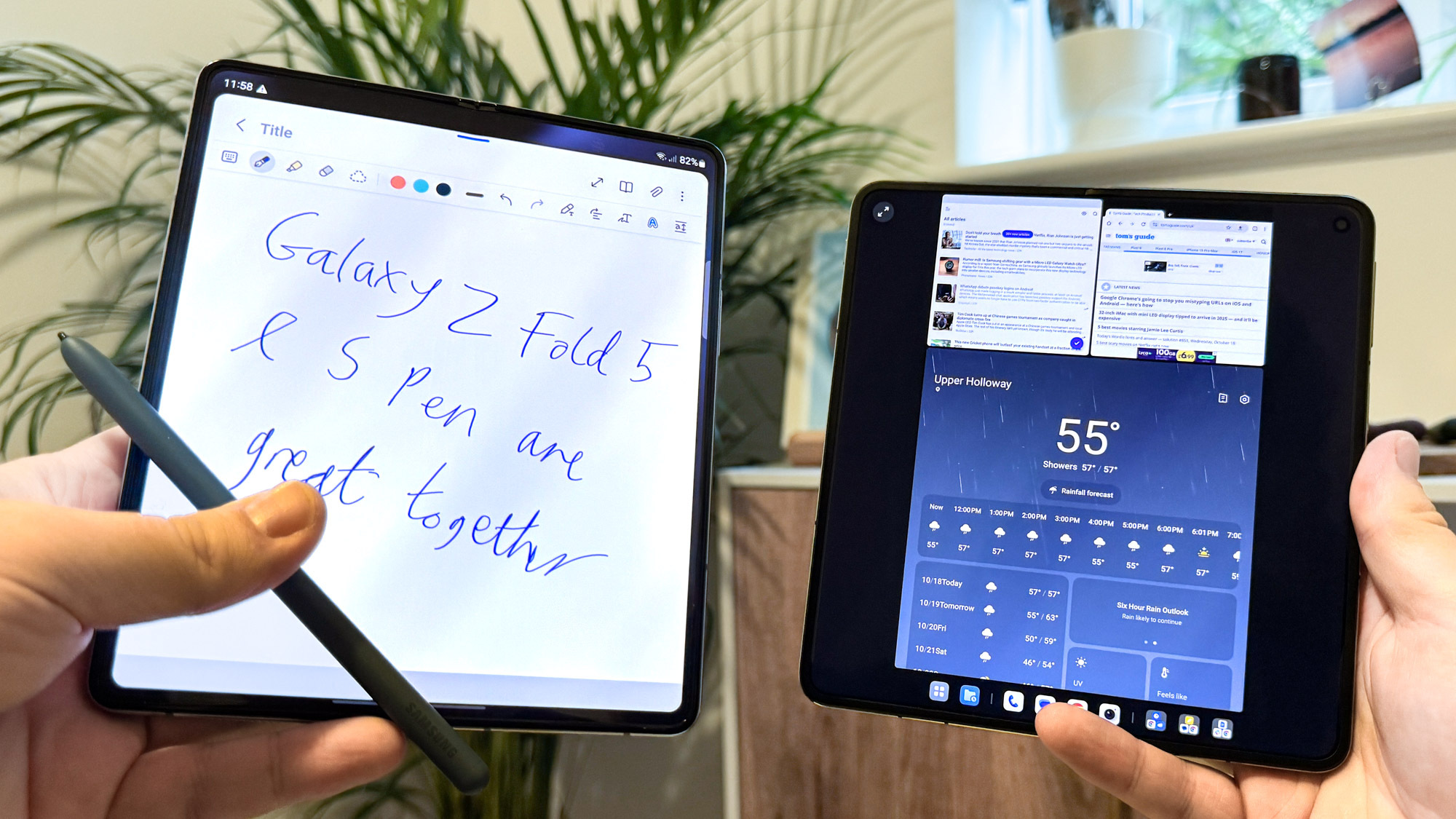
The Z Fold also offers the option to open two apps on either side of its main display, plus a smaller slide-over window on top, that you can easily move and copy/paste items between. This is certainly handy, but it's not quite as flexible as the OnePlus Open's Open Canvas system.
Open Canvas allows for up to three full app windows to be open at once, at one of two size options. These windows can be rearranged in multiple permutations, and can be used in a zoomed-out view that shows you everything at once, or focused-in on one app at a time. It's a much smoother system than Samsung's, and doesn't crush the apps into weirdly narrow windows, either.
Both phones offer a taskbar when opened fully, allowing for easier switching between apps and set-up of multi-app combos. You can open any app from these taskbars with a dedicated app, but the OnePlus also has a file explorer option that lets you bring up recent photos and files to bring into your active apps with ease.
Winner: OnePlus Open
OnePlus Open vs. Samsung Galaxy Z Fold 5: Verdict
Both of these foldables are great phones, but we need to pick a winner. And based on our scoring below, the OnePlus Open just ekes out a victory over the Galaxy Z Fold 5.
| Row 0 - Cell 0 | OnePlus Open | Samsung Galaxy Z Fold 5 |
| Price (10 points) | 4 | 2 |
| Design (10 points) | 8 | 6 |
| Displays (15 points) | 10 | 13 |
| Cameras (25 points) | 17 | 20 |
| Performance (15 points) | 11 | 13 |
| Battery and charging (15 points) | 9 | 6 |
| Software and special features (10 points) | 9 | 6 |
| Total | 68 | 66 |
Samsung's obviously been in the foldables game for a lot longer, but as a result, it's stagnated somewhat. Meanwhile, the OnePlus Open offers a fresh take on foldables, but one that builds upon sister-company Oppo's hardware which has helped guarantee quality and reliability for this initial release.
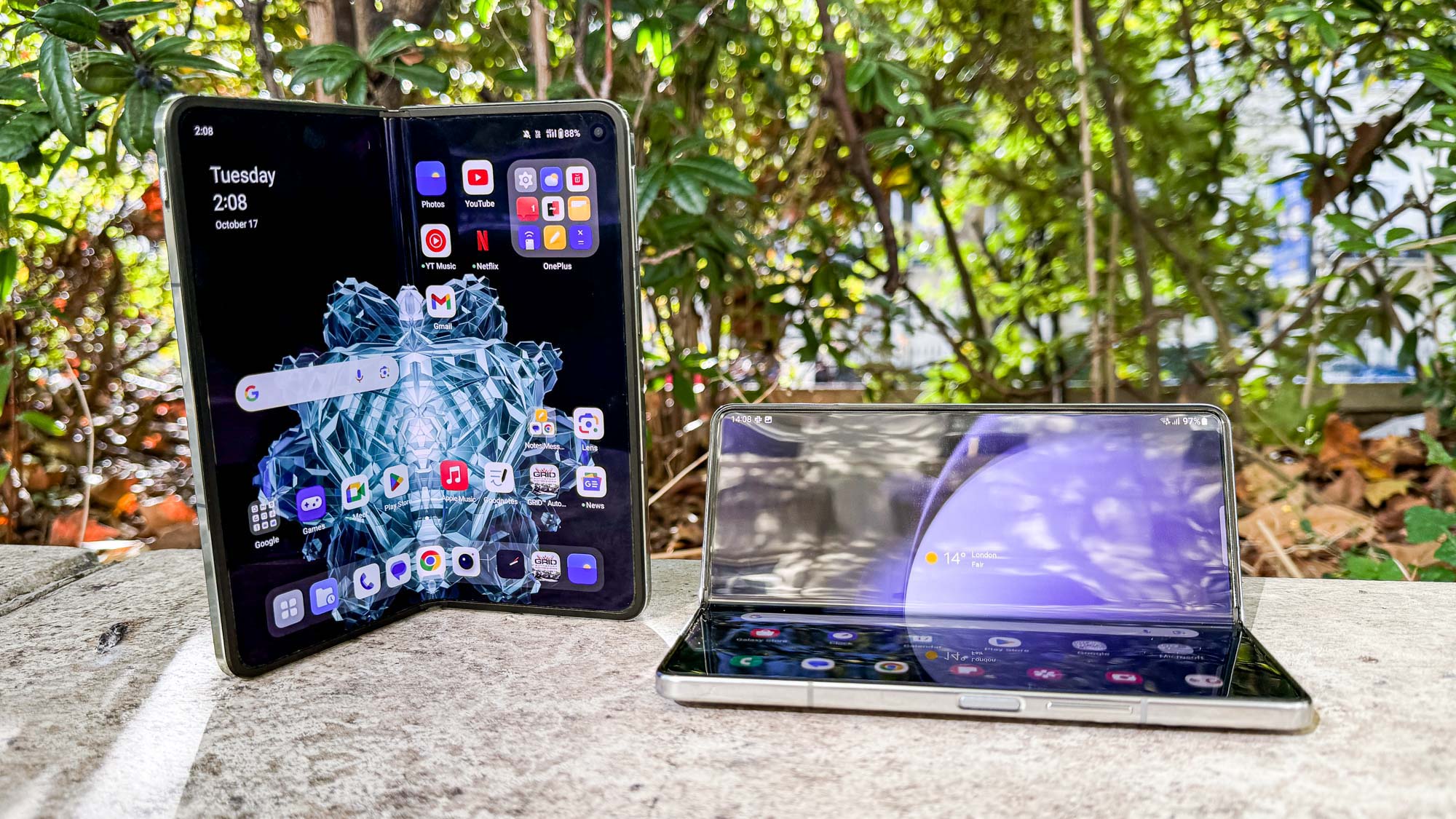
Even if you miss the pre-order period, the OnePlus Open remains the better bargain of the two phones, and could be a better productivity device assuming you don't see the need for a stylus. The better battery life and charging speeds sweeten the deal too.
However, if you like the sound of superior photography, performance power and display quality, and particularly if you want the option of a dedicated (albeit optional) stylus, perhaps you'd prefer spending the extra money to get the Galaxy Z Fold 5.
More from Tom's Guide
Sign up to get the BEST of Tom's Guide direct to your inbox.
Get instant access to breaking news, the hottest reviews, great deals and helpful tips.

Richard is based in London, covering news, reviews and how-tos for phones, tablets, gaming, and whatever else people need advice on. Following on from his MA in Magazine Journalism at the University of Sheffield, he's also written for WIRED U.K., The Register and Creative Bloq. When not at work, he's likely thinking about how to brew the perfect cup of specialty coffee.
-
dglacier Replyadmin said:Which foldable phone comes out on top in a battle between the latest Samsung Galaxy Z Fold 5 and the brand-new OnePlus Open? This OnePlus Open vs. Samsung Galaxy Z Fold 5 face-off will decide.
OnePlus Open vs. Samsung Galaxy Z Fold 5: Which foldable phone wins? : Read more
Well the Samsung actually wins on this one because even though you said the battery was just a difference of 15 minutes charging and it has the advantage of wireless, it should not have been given a losing score. And if you add the fact that yes, you can have three windows all at once on Samsung as well ,then Samsung would actually be the winner :-) and if you want to add some additional points you can mention the winning Samsung y
OneUI ecosystem. Now we can see the Samsung is way ahead:-)
